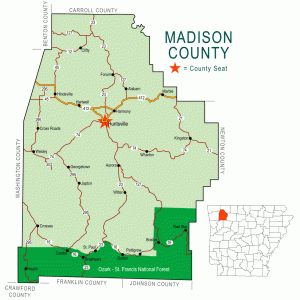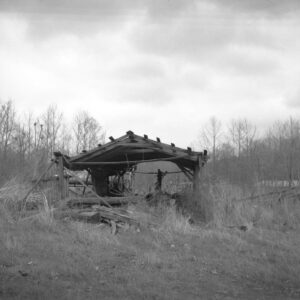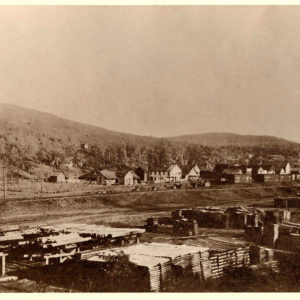calsfoundation@cals.org
Pettigrew (Madison County)
During the early twentieth century, Pettigrew, a small Madison County town located near the White River, was known by many as the “Hardwood Capital of the World.” At its peak, the town, which was situated at the end of the railroad line, was the major shipping station for the many area timber operations.
Vast acres of virgin timber and the coming of the railroad were the main factors that led to the founding and growth of Pettigrew. By the late 1880s, a small settlement had begun to develop along the White River. In about 1897, George Pettigrew, a civil engineer with the St. Louis–San Francisco Railway (Frisco), selected a track route into the timber lands and laid out the town’s first two streets, naming them George and St. George after himself. With the completion of the railroad in 1897, that early growth quickly developed into a timber boom town that also bears his name.
A post office was established in 1898. The most activity occurred from approximately 1900 until the close of World War I. During that time, more than a dozen stave mills and lumber firms operated in or near the town, many of them operating twenty-four hours a day. Phipps Lumber Company, the largest in northwest Arkansas, was one of them. During the town’s peak production, more than 200 wagons a day delivered cut timber, staves, cooperage, and ties. In 1919, S. D. Albright shipped in trucks by rail to replace many of the wagons. By then, Pettigrew was the largest lumber shipping center in the world. Among the major purchasers were the Singer Company and Fulbright Wood Products.
The town included some ten general stores, two drugstores, two hotels, several boarding houses, two doctors, and one dentist. Telephone and telegraph service was available by 1900. The Citizens Bank, founded by Charles Crawford, opened in 1907. A Masonic lodge, Alpha Lodge No. 637, was founded that same year. Being situated at the end of the railroad line, the town included a roundhouse and turntable where locomotives could be rotated for the return trip down the line.
In 1918, banker Charles Crawford began an advertising campaign to attract an editor to establish a town newspaper. William Keithley of Illinois answered the call and, on August 16, 1918, published the first issue of the Pettigrew Journal. However, in June 1919, upon the death of his wife, Keithley suspended publication and moved away before the end of the year.
By the 1920s, the town became less isolated with the completion of State Highway 16 to Dutton (Madison County), some three miles to the west. It would connect with Pettigrew by 1935. A two-room schoolhouse, which served as a church for a time, was completed in 1920. Up to 130 students from grades one through eight attended. After completion of the eighth grade, students were enrolled at St. Paul (Madison County). A church building was constructed after the Masonic hall burned in 1918. The second floor, which was removed in 1969, was used by the Masons. The building still stands as of 2011.
The area began to experience an economic decline by the late 1920s and early 1930s. Early evidence of the Great Depression is seen in the closing of the bank on December 20, 1930. Still, the Pettigrew Canning Company, which processed green beans and tomatoes, opened in the mid-1930s, replacing jobs lost by the downturn in the timber industry. The seriousness of the decline was felt in 1936 when the Frisco railroad petitioned the Interstate Commerce Commission for permission to take up the railroad tracks. The completion of State Highway 16 connecting with State Highway 23 had greatly reduced the profitability of the tracks. Permission was granted, the depot was sold at auction, and, when the last train left the town in July 1937, the tracks were removed, leaving only the roadbed.
Over the next few years, timber operations began to shut down, and town businesses began to close. By the 1950s and 1960s, little remained of the once prosperous boom town. By 1964, only a small settlement remained with two general stores, a café, a post office, a gas station, the school building, a church, and a few houses. While some small timber operations still remain in the area, most area residents live on small farms raising beef cattle. Its proximity to the Ozark National Forest is about all that attracts visitors to Pettigrew today. Famed basket maker Leon Niehues settled near Pettigrew in 1974. As of 2011, the school building (which serves as the Pettigrew Community Building and was added to the National Register of Historic Places in 1995), the church building, a few houses, and the remains of the last general store are all that have survived. Each spring, a celebration known as Pettigrew Days is held.
For additional information:
Bayles, Marion. “Pettigrew, Ark. In Early 1900’s.” Madison County Record, November 22, 1962, p. 8.
Martin, Wayne. Pettigrew: Hardwood Capital of the World. Springdale, AR: Shiloh Museum of the Ozarks, 2010.
Owens, J. J. “Pettigrew Was a Bustling Town.” Arkansas Democrat, November 22, 1964, p. 2.
“Pettigrew 1900–1927.” St. Paul Mountain Air, May 28, 1927, p. 2.
Mike Polston
CALS Encyclopedia of Arkansas
 Citizens Bank and Trust Company
Citizens Bank and Trust Company  Madison County Map
Madison County Map  Leon Albert Niehues
Leon Albert Niehues  Pettigrew Building
Pettigrew Building  Pettigrew Mill
Pettigrew Mill  Pettigrew View
Pettigrew View 




Comments
No comments on this entry yet.